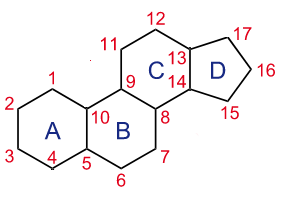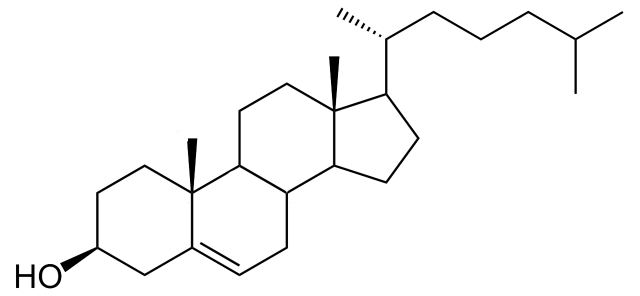OVERVIEW
Cholesterol is a conditionally essential nutrient, which is needed for brain health, cell membranes, and making a variety of steroid hormones, including cortisol, estrogen, progesterone, testosterone. It is also important for intra-cellular signaling between neurons (i.e. forming synapses). It is naturally made by all animals, including humans.
Cholesterol is only one member of a large family of related compounds called sterols.
All sterols share the same 17-carbon "backbone" consisting of 4 rings (named A, B, C, and D).
this basic structure is shown below:

This basic backbone is modified by attaching various "side chains" or "decorations" to different
numbered positions and/or by removing hydrogen atoms to create double bonds or aromatic rings,
which result in a number of different steroid hormones such as Vitamin D, estrogen, testosterone,
cortisol, aldosterone, and progesterone. The complete structure of cholesterol is shown below:

In this case, decorations are added at the 3, 10, 13, and 17 positions,
and a double bond is created between the 5 and 6 positions.
Dietary sources of cholesterol are only from animals. Vegans are at increased risk of deficiency.
It is possible for cholesterol to be too high, leading to cardiovascular complications, or too low. The exact healthy range is controversial, and may be tied to a patient's APOE genetics.
In general, steroids are not soluble in water, and are carried in the blood by various carrier proteins, such as HDL (high density lipoprotein, sometimes called "good cholesterol"), LDL (low density lipoprotein, sometimes called "bad cholesterol"), and SHBG (sex-hormone binding globulin).
Blood lipid tests that report HDL, LDL, etc are not really reporting cholesterol directly - but instead the amount of these carrier protein complexes. In fact, HDL and LDL both transport cholesterol and other lipids, including fatty acids. HDL is considered "good" because it scavenges un-needed lipids from the cells, and carries them back to the liver for energy production or expulsion from the body via bile.
On the other hand, LDL carries dietary lipids from the liver out to the cells of the body.
The medical establishment has claimed that LDL-cholesterol is "bad" and urged that dietary intake of cholesterol should be limited and the body's production of cholesterol should be suppressed using statin drugs.
This orthodoxy has been challenged by more recent scientific thought. In truth, both HDL and LDL are necessary and "good" - but their functions must occur in the proper balance.
Rather than focusing on total cholesterol and LDL-cholesterol, Dr. Barry Sears has shown that a ratio of HDL Triglycerides in the blood near 1:1 is most healthy. Most Americans have TG that is too high and HDL that is too low; dietary intervention (e.g. the Zone Diet) can bring these markers into balance.
DOSAGE
- Recommended Dietary Allowance (Adults): Controversial - allopathic authorities tend to discourage cholesterol consumption.
SEEALSO
-
Phytosterols







![[Wiki]](../images/earth_hover.gif)